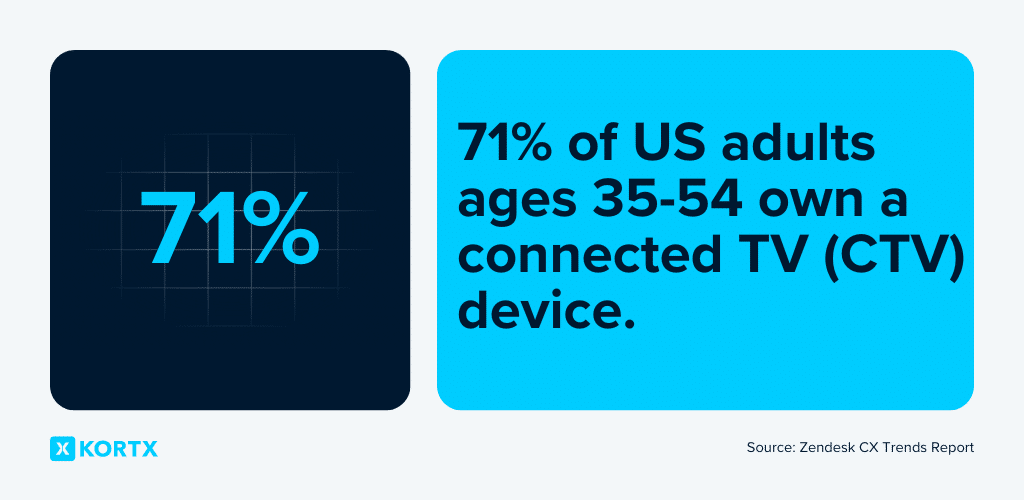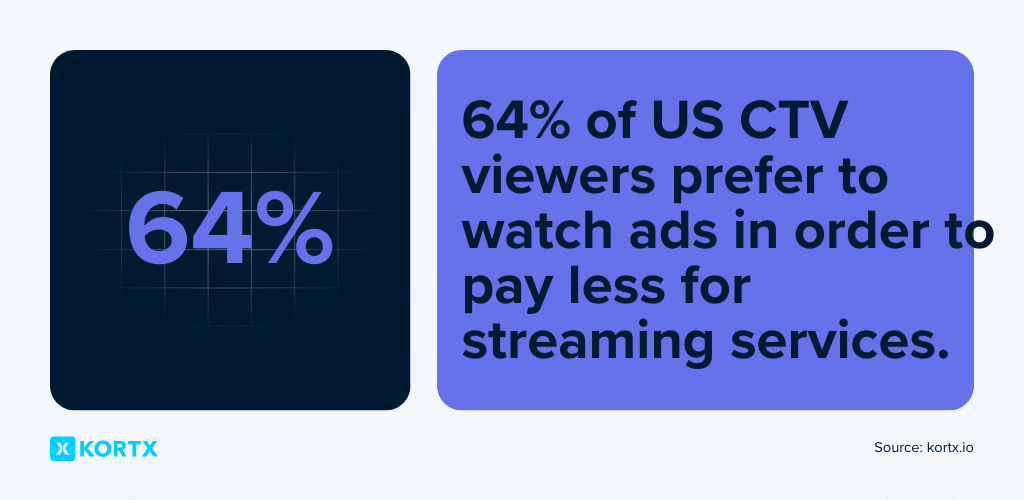Experiences refined for people
Experiences refined for people
Connected TV (CTV) targeting requires knowing your audience’s preferences, identities, and optimal viewing times.
Enhance your CTV advertising by mastering targeted messaging. Deliver the right message to the right people at the right time.
These nine CTV targeting methods are foundational to an impactful CTV advertising strategy.
Unlike linear TV’s broad-strokes targeting, Connected TV offers precision audience targeting. Each data source offers unique targeting benefits and challenges.
First-Party data is collected directly from your audience through your websites, apps, or CRM systems, making it both highly relevant and specific to your brand.
Second-Party data is First-Party data shared through a partnership with a trusted third party or another organization’s audience.
Organizations without a direct connection to individuals collect Third-Party data, typically compiling it from multiple sources and platforms like Oracle and Nielsen.

📚 Related Article: What is First-Party Data? A Guide to Data-Driven Marketing
Discover why First-Party data is vital to your CTV advertising success.
Each data type—First-, Second-, and Third-Party—is crucial to CTV targeting strategies. This combination refines targeting, aligning campaigns with audience segments for lasting results.
Explore the different CTV targeting strategies below, including why they’re important and how the KORTX team used them in the past in client media campaigns, including CTV.
Note: While this article highlights the success of different targeting methods by showcasing successful case studies, it’s important to note that successful marketing campaigns typically employ a blend of multiple targeting methods.
Demographic targeting reaches specific demographics, enhancing campaign precision. Perfect for crafting detailed audience personas.
How: First-Party data is used for segmentation by age, gender, and other key audience traits. Second-Party insights are enriched for depth, and Third-Party data provides a broader context.
Example: Gen Z College Admissions Marketing
Using demographic targeting, Quinnipiac University partnered with KORTX to tailor digital advertising strategies, including CTV, to Generation Z’s unique expectations, resulting in over 6,000 applications and a cost-per-application of $125, exceeding initial expectations.
How do precise targeting options for Connected TV create effective campaigns and generate maximum returns?
“Connected TV offers exceptional targeting precision compared to traditional TV advertising channels. With the ability to zero in on audiences by demographic, geographic, behavioral, interest-based profiles, and more, you can craft campaigns with laser focus.”

Behavioral targeting is ideal for retargeting and promoting related products, increasing conversion chances.
How: It uses First-Party data to track past behaviors, and third-party data adds scale and variety to behavioral insights.
Example: Interactive CTV & Jaylen Hurts
KORTX and Athlete Studio effectively promoted merchandise to NFL fans by employing interactive Connected TV advertising, leveraging Picture-in-Picture (PIP) technology and in-stream ads to showcase products during live sports broadcasts. This resulted in seven publisher placements and a 99% video completion rate.

Geographic targeting boosts efficiency for location-driven campaigns, ensuring ads reach the right regional audience.
How: It utilizes First-Party and Third-Party location data to pinpoint targeting down to city or zip code levels.
Example: Tropical Smoothie Cafe
Leveraging a digital-centric strategy with a focus on geographic targeting, KORTX helped Tropical Smoothie Cafe understand customer demographics and behaviors at national, regional, and local levels, significantly boosting online revenue to over $27 million and achieving a 6.6X return on ad spend.
Interest-based targeting engages users by aligning ads with their hobbies and passions, enhancing user engagement.
How: It analyzes First-Party data from digital interactions and supplements with Third-Party data for broader interest patterns.
Example: Trustmark Bank Full Funnel Marketing
KORTX leveraged Axon Audience Manager to discover previously unknown interests of Trustmark Bank’s audience, such as college sports and travel, implementing a targeted full-funnel marketing strategy across Display, Audio, Video, and Connected TV to target the identified audience.
This resulted in a 97% video completion rate and marked improvements in customer experience.

Retargeting builds deeper connections by aligning messages with user values and lifestyles, which is beneficial for emotional brand engagement.
How: Retargeting digs into First-Party engagement data, complemented by Second-Party insights for a nuanced view of user interests.
Example: Beaumont Health
Beaumont Health partnered with KORTX, embracing a HIPAA-compliant digital marketing strategy that combined contextual targeting with retargeting, transitioning to a digital-first approach. This shift yielded over $500k in revenue and a 4.69x ROAS.
Lookalike audience targeting expands reach to new, relevant audiences likely to convert, utilizing the predictive power of existing data.
How: Lookalike audience targeting starts with First-Party data to identify similar behaviors, with Third-Party data broadening the scope to find new matches.
Example: Faith-Based Marketing: Lowering Donation CPA with 1P Data
KORTX significantly enhanced a faith-based donation campaign’s efficiency by leveraging First-Party data and lookalike modeling for Connected TV, Display, and OTT. This tripled the Return on Ad Spend (ROAS) and lowered the Cost Per Acquisition (CPA), driving a total donation amount of $585,125 with an impressive overall ROAS of 2.7:1.
What advantages does lookalike modeling offer over traditional 3P and contextual targeting methods?
“The decline in reliability of Third-Party data and the narrow focus of contextual targeting on location rather than the individual underscore the need for a more refined approach. Lookalike modeling challenges this notion by utilizing shared behaviors and characteristics, leading to precise targeting and efficient budget use. It offers deep insights into customer preferences, aligns closely with like-minded audiences, and adapts to shifting customer bases, ensuring enhanced engagement and optimal use of advertising budgets.”

📚 Related Article: Lookalike Modeling: Making Every Ad Dollar Count
Understand why lookalike modeling leads to high-quality lead generation and a comprehensive audience understanding.
Cross-device targeting expands ad experiences across devices, leveraging each platform’s unique capabilities and shifts engagement beyond the TV screen.
How: Cross-device targeting employs First-Party data for understanding device usage, enhanced with Third-Party data for comprehensive cross-platform insights.
Example: KORTX’s Device Graph & NFM
Our partnership with NFM utilized cross-device targeting for broader CTV and Online Video (OLV) reach. led to 68,402 cross-device activities, an 18.6% increase in Purchase Revenue, and a notable 70% Return on Ad Spend (ROAS), achieving $30.876 million in Online Sales.

📚 Related Article: The Art of Cross-Device Targeting
Explore how cross-device targeting offers precise measurement & expands your reach across your campaigns.
Dynamic creative optimization (DCO) personalizes ad experiences, directly appealing to user interests and behaviors, thereby maximizing conversion potential.
How: DCO uses algorithms to analyze First-Party data in real-time, adjusting creatives for personalized messaging, and Third-Party data enriches the content pool.
Example: NatureSweet
KORTX and Smiths Agency exceeded KPI benchmarks for NatureSweet’s digital campaign, achieving a 4% brand lift with Captivate and a 0.20% overall campaign brand lift. The campaign utilized Connected TV, Pre-Roll Video, and Cross-Platform Display to drive awareness and enhance audience reach.
Contextual targeting capitalizes on user attributes on where they will likely consume content.
How: Contextual targeting begins by creating audience personas using existing data and tools like KORTX Intelligence to identify preferred networks and publishers.
Example: Tier 1 Automotive: Lincoln
KORTX successfully transformed Lincoln’s Tier 1 automotive campaign, repurposing existing content to resonate with multicultural audiences. Leveraging KORTX Intelligence, the campaign strategically placed tailored content across Connected Television (CTV) and Rich Media platforms, resulting in a .17% CTR, 317,553 clicks, and 6,351 leads.
Marketers typically employ a mix of various CTV targeting strategies for each campaign, blending data-driven insights with dynamic creative approaches to tailor their messaging. This multifaceted methodology allows for a more nuanced engagement with audiences, optimizing reach and resonance across different platforms.
Discover how KORTX’s Connected TV targeting services can help you reach your intended audience while maximizing your budget.
Drew Pytel is a Senior Account Strategist at KORTX. He enjoys golf, bourbon, and being active with his wife and 3 kids.
From us to your inbox weekly.